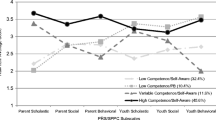Abstract
This paper compares the characteristics of 274 children whose parents agreed to provide information about their children's functioning in research with children whose parents did not. Parents had provided permission for child participation in school-approved research. Measures included self-, peer, teacher, and parent ratings. Parents of minority children were less likely to participate than parents of nonminority children. Among nonminorities, children of parent participants were viewed as more socially skilled and liked by their peers; teachers rated them as having less attention problems, less depression, and better academic skills than children of nonparticipating parents. Among minorities, no differences emerged. Implications for research involving the use of parent ratings are discussed.
Similar content being viewed by others
References
Achenbach, T. M., & Edelbrock, C. (1983).Manual for the Child Behavior Checklist and Revised Child Behavior Profile. Burlington: University of Vermont, Department of Psychiatry.
Beck, S., Collins, L., Overholser, J., & Terry, K. (1984). A comparison of children who receive and do not receive permission to participate in research.Journal of Abnormal Child Psychology, 12, 573–580.
Blount, R. L., Frank, N. C., & Calhoun, K. C. (1992). The recruitment and retention of minority students.The Clinical Psychologist, 45, 1–2.
Coie, J. D., Dodge, K. A., & Coppotelli, H. (1982). Dimensions and type of status: A cross age perspective.Developmental Psychology, 18, 557–570.
Earls, F. (1980). The prevalence of behavior problems in 3-year-old children: Comparison of the reports of mothers and fathers.Journal of the American Academy of Child Psychiatry, 19, 439–452.
Frame, C. L., & Strauss, C. C. (1987). Parental informed consent and sample bias in grade-school children.Journal of Social and Clinical Psychology, 5, 227–236.
Garrison, W. T., & Earls, F. (1985). The Child Behavior Checklist as a screening instrument for young children.Journal of the American Academy of Child Psychiatry, 24, 76–80.
Graham, S. (1992). Most of the subjects were White and middle class: Trends in published research on African-Americans in selected APA journals, 1970–1989.American Psychologist, 47, 639–639.
Jones, R. L. (1988). Psychoeducational assessments of minority group children: Issues and perspectives. In R. L. Jones (Ed.),Psychoeducational assessment of minority group children: A case book (pp. 13–35). Berkeley, CA: Cobb & Henry.
Jones, R. T., & Herndon, C. (1992). The status of Black children and adolescents in the academic setting: Assessment and treatment issues. In C. E. Walker & M. C. Roberts (Eds.),Handbook of clinical child psychology (2nd ed.). (pp. 901–917). New York: John Wiley and Sons.
Kazdin, A. E., Esveldt-Dawson, K., Unis, A. S., & Rancurello, M. D. (1983). Child and parent evaluations of depression and aggression in psychiatric inpatient children.Journal of Abnormal Child Psychology, 11, 401–413.
La Greca, A. M. (1981). Peer acceptance: The correspondence between children's sociometric scores and teachers' ratings of peer interactions.Journal of Abnormal Child Psychology, 9, 167–178.
La Greca, A. M., Dandes, S. K., Wick, P., Shaw, K., & Stone, W. L. (1988). The development of the Social Anxiety Scale for Children (SASC): Reliability and concurrent validity.Journal of Clinical Child Psychology, 17, 84–91.
La Greca, A. M., & Stone, W. L. (1990). Children with learning disabilities: The role of achievement in their social, personal and behavioral functioning. In H. L. Swanson & B. Keogh (Eds.),Learning disabilities: Theoretical and research issues. Hillsdale, NJ: Erlbaum.
La Greca, A. M., & Stone, W. (1993).The Social Anxiety Scale for Children-Revised: Factor structure and concurrent validity. Journal of Clinical Child Psychology, 22.
Landau, S., & Milich, R. (1990). Assessment of children's social status and peer relations. In A. M. La Greca (Ed.),Through the eyes of the child: Obtaining self-reports from children and adolescents (pp. 259–291). Boston: Allyn & Bacon.
Loeber, R., Green, S. M., & Lahey, B. B. (1990). Mental health professionals' perception of the utility of children, mothers, and teachers as informant on child psychopathology.Journal of Clinical Child Psychology, 19, 136–143.
Mash, E. J., & Johnston, C. (1983). Parental perceptions of child behavior problems, parenting, self-esteem, and mothers' reported stress in younger and older hyperactive and normal children.Journal of Consulting and Clinical Psychology, 51, 86–99.
McLoyd, V. C., & Randolph, S. M. (1985). Secular trends in the study of Afro-American children: A review ofChild Development, 1936–1980.Monographs for the Society for Research in Child and Adolescent Development, 50, 78–92.
Reynolds, C. R., & Richmond, B. O. (1978). What I think and feel: A revised measure of children's manifest anxiety.Journal of Abnormal Child Psychology, 6, 271–280.
Reynolds, C. R., & Richmond, B. O. (1985).Revised Children's Manifest Anxiety Scale Manual. Los Angeles, CA: Western Psychological Services.
Sarason, S. B., Davidson, K. S., Lighthall, F. F., & Waite, R. R. (1958). A test anxiety scale for children.Child Development, 29, 105–133.
Sarason, S. B., Davidson, K. S., Lighthall, F. F., & Waite, R. R., & Ruebush, B. K. (1960).Anxiety in elementary school children. New York: John Wiley.
Silverman, W. K., Fleisig, W., Rabian, B., & Peterson, R. A. (1991). Childhood anxiety sensitivity index.Journal of Clinical Child Psychology, 20, 162–168.
U.S. Department of Commerce. (1991).Bureau of Census statistical abstract of the United States for 1989. Washington, DC: U.S. Government Printing Office.
Wolfe, D. A., & Mosk, M. D. (1983). Behavioral comparisons of children from abusive and distressed families.Journal of Consulting and Clinical Psychology, 51, 702–708.
Author information
Authors and Affiliations
Rights and permissions
About this article
Cite this article
La Greca, A.M., Silverman, W.K. Parent reports of child behavior problems: Bias in participation. J Abnorm Child Psychol 21, 89–101 (1993). https://doi.org/10.1007/BF00910491
Revised:
Issue Date:
DOI: https://doi.org/10.1007/BF00910491




